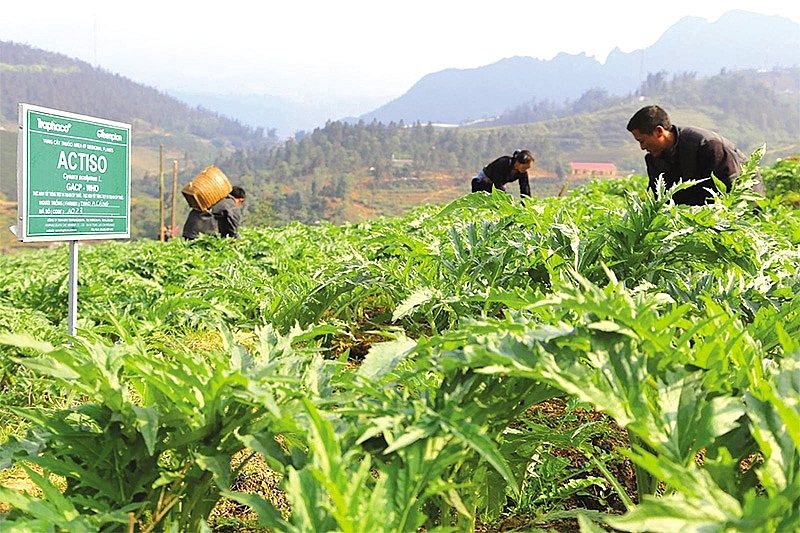Herbal cultivation for sustainability
 |
| Herbal cultivation areas are essential for sustainable development of pharmaceuticals |
Emerging drugmaker CVI Cosmetic & Pharmaceutical JSC (CVI Pharma) is preparing to open its hi-tech factory costing nearly VND300 billion ($13 million) on an area of 1.1 hectare in Hanoi’s Hoa Lac Hi-tech Park early next year.
“When the facility is in place, we will develop herbal cultivation areas to ensure the supply of clean and quality materials for our manufacturing, thus increasing the value chain in the time to come,” said Phan Van Hieu, chairman of CVI Pharma. “At present, we rely much on partners to supply materials for production.”
CVI Pharma is only one of a number of Vietnamese pharmaceutical companies heading towards an inclusive business model, in which drugmakers partner with local farmers to develop cultivation areas to ensure sustainable material supply, while creating jobs.
Nguyen Quang Vinh, vice chairman of the Vietnam Business Council for Sustainable Development, told VIR, “There are many models for sustainable business development like the inclusive business model. This model is now a trend among pharmaceuticals in Vietnam, and has proved successful in many countries in helping businesses develop sustainably.”
Back in 2002, Vietnam’s second-largest publicly-traded drugmaker Traphaco began a herbal cultivation area in Sapa district of the northern province of Lao Cai, where the majority of the population are ethnic minorities with out-of-date cultivation techniques. Traphaco has provided training on the cultivation of artichokes, which has helped improve local people’s lives.
38-year-old Thao A Tu, who is living in Sapa, is an example of how planting artichokes have improved the lives of hundreds of locals. Before 2011, his family was struggling to get by, but he has a better life now.
Before 2011, his family members had no stable job, but relied on vegetable cultivation with a low output. Thus, after the harvest season, they struggled to find jobs. He joined Traphaco’s artichoke cultivation and his family’s life has changed for the better.
At present, Traphaco has five herbal cultivation areas meeting GACP-WHO standards, all aligned with the principles of environment protection from seeds, cultivation techniques, harvest and processing; to water, green fertiliser, and green land.
Other pharma firms, such as Vietnam’s third-largest domestic drugmaker Domesco (DMC), Hau Giang Pharmaceutical JSC (DHG), and Imexpharm Pharmaceutical JSC, have been making similar moves. They were all named on the 2016 list of 100 businesses honoured in the programme of benchmarking and ranking sustainable companies in Vietnam.
DMC and DHG have so far been focusing on developing herbal cultivation areas, and have plans to expand an additional 1,000ha of herbal trees nationwide.
Doan Dinh Duy Khuong, CEO of DHG, said, “The company plans to increase the proportion of products made from natural materials to develop its value chain, thus growing sustainably and helping to improve the lives of farmers.”
According to the Ministry of Health’s Drug Administration of Vietnam, manufacturing and production of traditional medicines needs around 500 kinds of herbal trees. However, due to the weak development of cultivation areas, Vietnam has to import the majority of herbs.
What the stars mean:
★ Poor ★ ★ Promising ★★★ Good ★★★★ Very good ★★★★★ Exceptional
Themes: Towards Sustainability
Related Contents
Latest News
More News
- First members of Danang International Finance Centre revealed (December 22, 2025 | 17:39)
- Human-centred governance seen as key to AI development (December 19, 2025 | 18:19)
- Top 10 notable events of Vietnam’s industry and trade sector in 2025 (December 19, 2025 | 14:00)
- Tungsten surges to 12-year high as world enters a new 'black gold' race (December 18, 2025 | 17:27)
- Vietnam’s coffee exports set new record despite price pressures (December 18, 2025 | 17:13)
- Garment and textile sector seeks new growth after volatile year (December 18, 2025 | 17:01)
- VinSpeed and Siemens strengthen cooperation for high-speed rail development (December 18, 2025 | 16:53)
- High-tech adoption for TH true MILK (December 18, 2025 | 13:39)
- Takeda supports health resilience amid climate change challenges (December 18, 2025 | 12:39)
- Mondelez Kinh Do - a chapter of purpose-led leadership in Vietnam (December 18, 2025 | 09:44)

 Tag:
Tag:






















 Mobile Version
Mobile Version